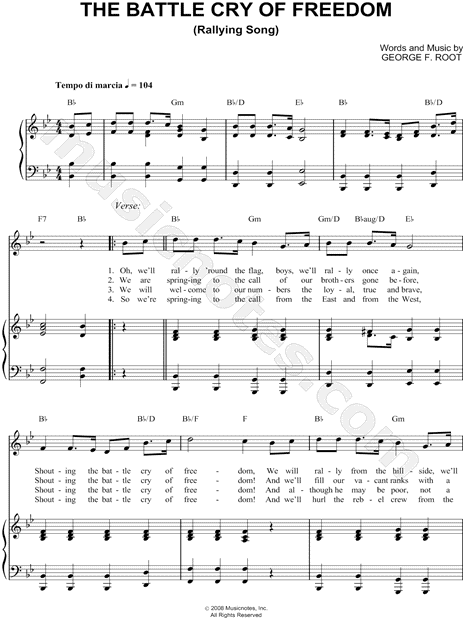

Schreiner of Macon, Georgia, resorted to smuggling a satchel of music type through Union lines in Tennessee. Some Southern music publishers, like J.C. They were severely handicapped by the shortage of ink, paper and type, which they had always imported from the North. With the coming of secession, the South’s few music publishers sprang into action. By the war’s end, this figure had grown to some 10,000 songs.īefore the war, the South had relied mainly on the North for its supply of printed music. In 1861 alone, an estimated 2,000 pieces of music were written and published in both the North and the South. To satisfy the enormous demand for the lyrics of the most popular Civil War songs, printing presses on both sides of the conflict ran around the clock. His most popular songs include “Battle Cry of Freedom,” “Just Before the Battle Mother,” “The Vacant Chair” and “Tramp, Tramp, Tramp.” Root would go on to become the single most important songwriter for the Union.

Entitled “The First Gun is Fired! May God Protect the Right,” it was written by George F. Within three days of the firing on Fort Sumter, the first published song of the Civil War was already on the streets. Many of Southern soldiers who returned from the war went on to name their daughters “Lorena.” Some writers have even gone so far as to blame the lost of the war on “Lorena.” So many Southern soldiers grew homesick and deserted after singing it, that several Confederate Generals prohibited their soldiers from singing “Lorena,” but most soldiers disobeyed orders and sang it anyway. They didn’t seem to care that it was written by a Northerner and first published in Chicago. Henry De Lafayette Webster and the melody by Joseph Philbrick Webster, who also wrote the music to “In the Sweet Bye and Bye.” Although “Lorena” was sung by soldiers on both sides, it was more widely sung by Southern soldiers. The lyrics were written as a poem by Rev. With little else to comfort them, “Lorena” reminded soldiers of the separation they endured through the war’s long years. The melody of “Home! Sweet Home!” was composed by Sir Henry Rowley Bishop, a well known English conductor who has known as “a notable reprobate, home-wrecker and spendthrift.” He died in poverty.Ĭertainly, one of the most popular Civil War songs that preceded the war was “Lorena.” It was written in 1857, long before the war tore soldiers from their wives and sweethearts. He eventually served time in a debtor’s prison. Far from home and loved ones, it is not all that surprising that the all-time favorite song of both sides was “Home! Sweet Home!” Ironically, of the two men who composed it, one was homeless and the other was known as a “home-wrecker.” The lyrics of “Home! Sweet Home!” were written by John Howard Payne for an opera that was first produced on May 8, 1823. Perhaps the most popular Civil War songs were actually those songs that were old or well known before the war. Sung by soldiers and by those who stayed behind, it was the songs that truly expressed the emotions, fired the patriotism and filled the emptiness felt by leaving loved ones at home and facing death at every turn. But although instrumental music was linked to almost every step the soldiers made, it was often the songs that mattered most. They were awakened in the morning with the first call of the bugle, riveted into step by drums and fifes, serenaded in camp by banjos, fiddles, harmonicas and jew’s harps and even put to sleep by a lone bugler. Music touched practically every aspect of soldiers’ lives. Lee said “I don’t believe we can have an army without music.” No less an authority than General Robert E. For soldiers on both sides of this conflict, it was the music that helped them carry on. As we approach the 150th or sesquicentennial anniversary of the start of the Civil War, let’s pause to remember an aspect of this tragic period beyond the roar of the cannons and the movement of soldiers across the battlefield.


 0 kommentar(er)
0 kommentar(er)
